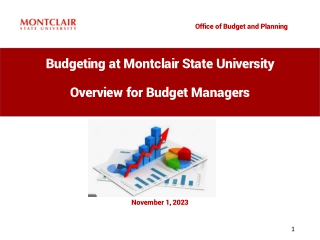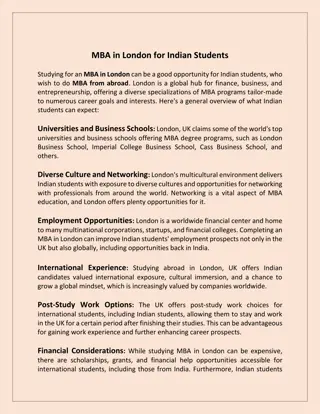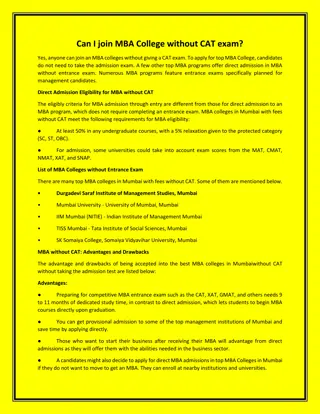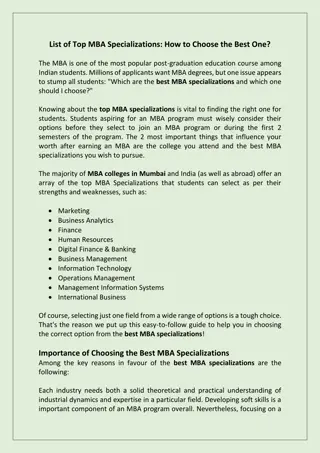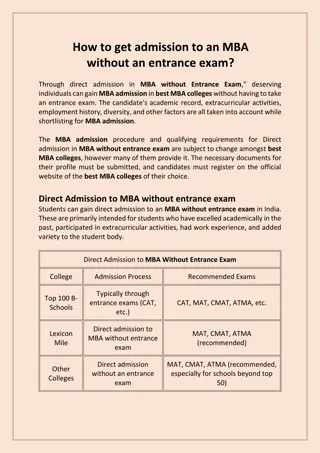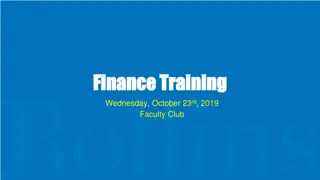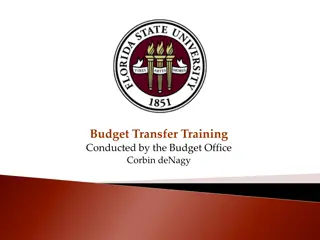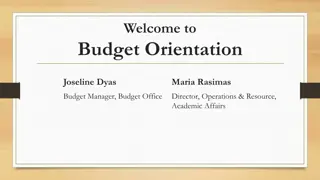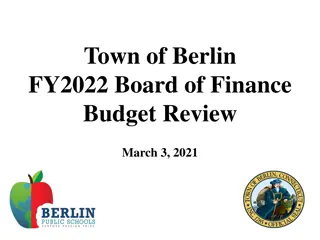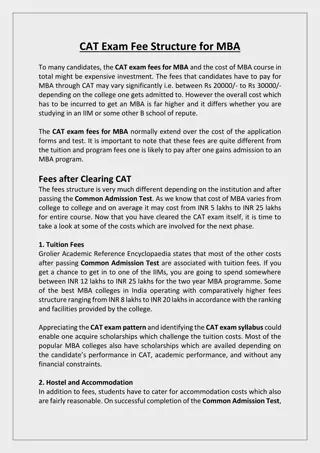MBA for Librarian Series: Budget and Finance Tips
Dive into the world of budgeting and finance with the "MBA for Librarian Series" presented by John Sandstrom. Gain insights and advice on terminology, methods, and techniques to enhance your understanding of budget management. Discover tips on asking questions, seeking training, and exploring different budgeting methods to optimize your library's financial strategies.
Download Presentation

Please find below an Image/Link to download the presentation.
The content on the website is provided AS IS for your information and personal use only. It may not be sold, licensed, or shared on other websites without obtaining consent from the author.If you encounter any issues during the download, it is possible that the publisher has removed the file from their server.
You are allowed to download the files provided on this website for personal or commercial use, subject to the condition that they are used lawfully. All files are the property of their respective owners.
The content on the website is provided AS IS for your information and personal use only. It may not be sold, licensed, or shared on other websites without obtaining consent from the author.
E N D
Presentation Transcript
Cost of Attendance Resident Non Resident $ 75,423 $ 105,746
Indirect Cost Resident Non Resident Living Expenses $ 26,500 $ 26,500 Transportation $ 2,000 $ 2,000 Health Insurance $ 3,600 $ 3,600 Books $ 1,380 $ 1,380 Commuting Expense $ 0 $ 1,200 Total $ 33,480 $ 34,680
Living Expenses Location Monthly Amount Off Campus Apartment $ 2,650 University Suites $ 2,650
Shopping with $300.00 per month
# Unit 4lbs 15Each 2Heads 2Bags 4lbs 4Each 2Each 3Each 3lbs 15 lbs 2Loafs 2Bags 2Dozen 1lbs Product Bananas Apples Lettuce Spinach Carrots Cucumbers Red Peppers Onions Tomatoes Potatoes Bread Bagels Eggs Sliced Cheese Shredded Cheese Lunch Meat Peanut Butter Jelly Chips/Pretzels Apple Sauce Price Total $0.59 $2.36 $0.55 $8.25 $1.99 $3.98 $2.49 $4.98 $0.99 $3.96 $0.99 $3.96 $2.49 $4.98 $0.47 $1.41 $2.99 $8.97 $3.99 $3.99 $1.99 $3.98 $2.15 $4.30 $1.99 $3.98 $2.99 $2.99 # Unit Product Yogurts Granola Bars Rice Cereal Waffles Condiments Price Total $0.50 $2.50 $1.50 $2.75 $2.25 $1.99 $1.65 $2.99 $2.49 $2.99 $2.99 $8.99 $17.98 $1.49 $1.00 $2.25 $1.99 $2.49 $1.50 $5.00 $2.25 20Individual 3Boxes 1Bags 3Boxes 1Boxes 2Bottles 41/2 Gallon Milk 11/2 Gallon Orange Juice 11/2 Gallon Apple Juice 3lbs 3lbs 2lbs 4Pouches 3Boxes 5Jars 1Pkg 1Jar 22-liter 1Can 1Bottle $10.00 $7.50 $1.50 $8.25 $2.25 $3.98 $6.60 $2.99 $2.49 $8.97 $8.97 Chicken Ground Meat Salmon Tuna Pasta Pasta Sauce Tortillas Salsa Soda Coffee grounds Creamer $5.96 $3.00 $11.25 $1.99 $2.49 $3.00 $5.00 $2.25 28 oz Bags 2lbs 1Jar 1Jar 2Bags 46-pks $2.50 $5.00 $5.99 $11.98 $2.99 $2.99 $2.00 $2.00 $2.99 $5.98 $2.25 $9.00
Budgeting Ideas and Tips Living on a budget as a medical student or resident is an essential step for minimizing the debt you ll face upon entering repayment. Try to think of a budget the same way you d think about maintaining a healthy diet: make sensible, responsible choices and you ll reap the benefits
Save Money and Time Make your own coffee or tea and buy a thermos. You ve probably heard this before; endless cups of coffee from a coffee shop can really increase expenses. If you really must pay for coffee, consider opting for a smaller size or limiting yourself to plain drip-coffee instead of fancier drinks. Your wallet and your waistline will thank you. Bag your lunch. Being short on time and having irregular hours will be less stressful if you have easy, healthy, homemade food with you. Not only will you save time and money, but you may also eat better. Shop smart. If you buy your groceries online, you may save time. If you go to the store, always bring a list to minimize impulse buying and browsing time. Join your market s shopper s club to take advantage of weekly specials. Design your menu based on weekly sales while taking advantage of manufacturer s coupons (available online as well as in the paper). Whenever possible, buy generic brands. Take control of your credit cards. Try not to carry a balance on your cards; this will save you money. Additionally, use credit cards that don t charge an annual fee. Avoid late fees. Pay your bills on time and online. Late fees add up and they may have a negative effect on your credit rating. If you do miss a payment, call the creditor and ask to have the late fee waived. Avoid ATM fees. Try to bank locally and use your bank s ATM for cash withdrawals. Bike to school/work. If your climate, schedule, and location are suitable, bike to school/work. It helps you keep in shape and it is less costly. To save even more money, buy a used bike. Take public transportation. It may be more cost effective not to rely on a car at all. Public transportation will alleviate the expenses of buying gas, maintenance, and parking. It might actually be less stressful too! The 30 Minute Rule:If you see something you have to have wait 30 minutes, then if you still can t live without it make the purchase. Think About It... Decide what makes sense for you. If you live more responsibly now and make smart choices about how you spend your money now, chances are, you ll be paying a lot less when you enter repayment. Small changes can make big differences over time.
Benefits of Budgeting Although the word budget often has negative connotations, it also offers many benefits. For example, you will find that a realistic budget will help you: Maintain better control of your spending and be less likely to run into credit problems. Cover your essential expenses before making optional purchases. Prepare for an unexpected expense by building an emergency fund.
How to Set Up a Budget The first step to budgeting requires that you know what your income (for a student, this is likely money from student loans) and expenses are each month. You will need to add up your income, determine your expenses, and calculate the difference to see if you have a surplus or deficit before you can actually create a budget. Some people have a hard time accurately determining what their expenses are each month, so they may need to take a month to track their expenses before actually formulating their working budget. It may help to categorize your expenses as either fixed (stay the same every month) or variable (fluctuate from month to month).
How to Set Up a Budget After you total your monthly expenses, and subtract that from your income, you will then know what your bottom line is. If you find that you don t have enough money to cover your expenses, consider making adjustments to your variable expenses; this may be an area in which you can make up for some of your shortfalls. Use the Budgeting Worksheet for Students to help you create your budget.
Next Steps? Use the aamc.org/FIRST site Develop your budget Schedule an appointment to review your budget


